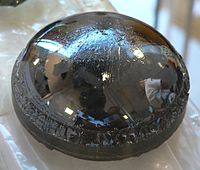
Photo from wikipedia
Abstract Different material compositions provide different hardness and wear resistance to Ti-6Al-4 V substrate against the external load. In order to normalize the effect of different characteristics properties of the material… Click to show full abstract
Abstract Different material compositions provide different hardness and wear resistance to Ti-6Al-4 V substrate against the external load. In order to normalize the effect of different characteristics properties of the material added to the coating, the ratio of (volumetric wear rate)Coating to (hardness)Coating has been proposed as an ‘index’ in the present study for comparison between the reported studies on laser cladding of Ti-6Al-4 V alloy. The lower ratio of (volumetric wear rate)Coating to (hardness)Coating would correspond to the higher wear resistance of the coating. According to the data reported until now on laser cladding of Ti-6Al-4 V alloy, the minimum (volumetric wear rate)Coating to (hardness)Coating has been found to be 4.08 × 10 - 8 mm3/N-m/HV (calculated from the reported data). In the present study, an attempt has been made to further reduce the ‘index’ by in-situ synthesis of ceramic particles in composite coating using B4C and SiC as precursor on Ti-6Al-4 V alloy by laser cladding. It was observed that (a) (hardness)Coating ≈ 6.5 (hardness)Substrate, (b) (volumetric wear rate)Coating ≈ 13 (volumetric wear rate)Substrate and (c) (scratch hardness)Coating ≈ 1.83 (scratch hardness)Substrate. The ratio of (volumetric wear rate)Coating to (hardness)Coating for the present study was found to be lower (= 2.5 × 10 - 8 mm3/N-m/HV) as compared to that of the previously reported literature on laser cladding of Ti-6Al-4 V alloy. The improvement in tribological property might have been possible due to the reaction of B4C and SiC with Ti-6Al-4 V substrate forming a composite coating containing ceramic phases such as TiB2, TiC, TiSi2 and V8C7.
Journal Title: Optik
Year Published: 2020
Link to full text (if available)
Share on Social Media: Sign Up to like & get
recommendations!